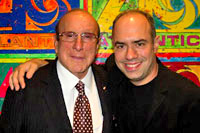A Fix For Insurance Maladies
 IF ONE BUSINESS MODEL DOESN’T SUCCEED, throw it out and try another.
IF ONE BUSINESS MODEL DOESN’T SUCCEED, throw it out and try another.
That’s how Jonathan Bush ’93 and a fellow healthcare consultant, Todd Park, handled their first foray into healthcare. They intended to use their management expertise to develop birthing centers that would be family-friendly and improve the quality of the experience for all concerned. With $1.6 million raised from private sources, the young entrepreneurs bought a clinic in San Diego to pursue their dream.
As it turned out, achieving success in the clinic was only half the battle, and collecting from insurance companies was far more challenging. They could not figure out how much money they were making or losing because the healthcare reimbursement system is so convoluted. As savvy managers, they reasoned that if they were having so much trouble, then many doctors must be at least as frustrated.
They got that one right.
Industry statistics suggest the magnitude of the problem. The average lag time between when a medical practice submits a claim and when it gets paid is 72 days. Roughly a quarter of claims—more for some doctors—result in denials of payment, often arising from the complexity of insurance codes. More than 5 percent of claims disappear into a bureaucratic rabbit warren and are never paid. The cost to physicians is huge.
The answer, Bush and Park figured, was to create a Web-based software system that incorporates all the millions of rules of insurance companies throughout the United States, and guarantee to doctors that their company, athenahealth, would prepare claims quickly and correctly.
From the perspective of Wall Street, athenahealth came into the world at a bad time. Carl Byers ’93, an early recruit who is now chief financial officer, says that the capital markets had completely given up on companies specializing in physician practice management.
“There were some spectacular collapses of companies that weren’t actually doing anything,” he says. “They would buy a lot of medical groups on the theory that someday they would add value. They really didn’t have ideas about how to improve healthcare.
“We thought of ourselves as ’the uncola’—we would add value first and then grow.”
Despite the unfavorable climate, athenahealth raised $10 million from venture capital firms in its first year. In 2000, just before the tech collapse, it raised $30 million—enough for early stage development. As the concept began to catch on with doctors, athenahealth moved to a remodeled industrial building located in the Boston suburb of Watertown. Once used to produce armaments, the building retains an industrial flavor for this high-tech enterprise.
Six years after its founding, athenahealth operates in 32 states with 8,000 doctors. It has 479 employees and, in 2005, more than $63 million in revenue. The company’s growth rate landed it last year as number 77 on Inc. 500, a ranking of the fastest growing companies in the nation.
Although computer algorithms are the heart of athenahealth, company staffers still push around a lot of paper. Executives dream of receiving everything electronically, but for now some 2,600 pounds of paper—representing 260,000 pages of information pertinent to claims—arrive every week. Scanners capable of processing 140 pages per minute gobble these and prepare them for the overnight shift in India, where a low-cost data processing company in Chennai extracts data and prepares it for entry into athenahealth’s proprietary system.
The result? Athenahealth has been able to cut the lag time to 45 days for its clients and boost their revenues by 5 to 10 percent.
The company’s business model made Jeremy Delinsky ’97 sit up in business school class at Wharton one day in 2001. A former consultant for Deloitte, he wrote down athenahealth’s name—the only name he bothered to remember out of 20 companies that visited the class that semester.
“Billing knowledge is our core expertise,” says Delinsky, director of process innovation. Athenahealth
The Wesleyan contingent of athenahealth includes executives John Lewis ’94, Carl Byers ’93, founder Jonathan Bush ’93, and Jeremy Delinsky ’97.
knows more about insurance rules than any doctor’s office ever could. When the company discovers an idiosyncrasy of a particular insurance company, its programmers embed the rule in the company’s proprietary software so that all their clients instantly can take advantage of this knowledge. Keeping up with the insurance industry is a constant, day-in and day-out marathon of tracking as many as 150 rule changes each week.
Fast Company magazine credits athenahealth as perhaps the only company in its field that unites both the front and back ends of a doctor’s office. It checks that a patient has valid insurance before the appointment; then it files claims, handles billing, and examines the rejected claims to find the source of error. In fact, learning from mistakes is a key part of creating an ever more sophisticated software system.
None of this is cocktail party conversation, as the company’s executives readily admit. But Fast Company also notes that Bush and Park “have managed to reframe athena’s work as nothing less than a heroic effort to help doctors focus on medicine, which in turn will result in everyone getting better and more responsive medical care.”
It’s a vision that appears to have special appeal for Wesleyan graduates. Four of the company’s executives are graduates of the CSS program: Bush, Byers, Delinsky, and Sales Executive John Lewis ’94, who joined the company in 2000 with a degree from Wharton in hand. Lewis learned about athenahealth from Byers at a Wesleyan reunion. The conversation immediately sparked his interest because he had written a paper at Wharton about the rise and fall of the market for physician practice management companies.
So far, athenahealth has claimed a scant one percent market share, but that makes it the largest company in its industry. In this highly fragmented market, with most physicians still handling their own claims processing, athenahealth has lots of room for growth.
Growth is on the mind of Bush, described by Fast Company as “a hyperactive Sean Penn look-alike.” A cousin of President Bush, he brings the Bush family name to the business, which undoubtedly helps to open some doors. He also has experience on the front lines of medicine, having served in the Army as a combat medic and having spent a summer as an EMT in New Orleans. Now that athenahealth has crossed the early hurdles of entrepreneurial businesses, he is looking for other areas of medical practice that are ripe for automation.
This includes a new clinical system designed to help physicians manage patient appointments from scheduling through recording health histories, documenting diagnoses, electronic prescribing, and preventive care.
In an interview with CNBC, Bush pointed out that, “$30 billion is flushed by physicians just in the process of chasing claims down, and another $30 billion is flushed down by payers trying to deal with physicians who send them wrong claims, and that’s just the claims. The whole process of lab tests, prescriptions, and other order cycles that run through health care have the same fundamental characteristics, and there’s huge possibility for fixing that stuff.”
Athenahealth is by no means the only company seeking to profit by bringing automated efficiency to medical practices, but Bush and his colleagues see their mission as rising above the bottom line. They are pursuing a progressive agenda through a capitalist strategy of building a business, he says. “We’re doing so much good.”

